Others
India's High-Tech Revolution: Driving Global Leadership in Advanced Technology & Manufacturing
Posted On:
11 SEP 2024 6:26PM

A massive technological and industrial transformation is unfolding in India. The Indian manufacturing sector is steadily moving toward more automated and process-driven manufacturing, which is projected to improve efficiency and enhance productivity. Technology has encouraged creativity, with digital transformation being a critical element in gaining an advantage in this increasingly competitive industry.
The government's efforts to turn India into a global electronics and semiconductor hub are supported by initiatives like the Production-Linked Incentive (PLI) schemes, mega industrial corridors, and major investments. In tandem with these, India’s renewable energy push, especially in solar energy and EV adoption, positions the nation at the forefront of clean energy technologies.
The SEMICON India 2024, which is being held from September 11-13, 2024, at the India Exposition Mart, Greater Noida, is a landmark event bringing together not only global leaders in the semiconductor space but also stakeholders from various high-tech industries. With India emerging as a focal point for renewable energy, electric vehicles (EVs), and the National Green Hydrogen Mission, the event promises to spotlight discussions on manufacturing, sustainability, workforce development, and government policies fostering innovation.
India Semiconductor Mission
About Semiconductors –
Semiconductors, also known as integrated circuits (ICs) or microchips, are essential components of our day-to-day lives due to their integral role in the fabrication of electronics like phones, computers, automobiles, planes, medical instruments, military weapons, home and kitchen appliances, solar cells, etc.
Semiconductor chips are present in all electronic instruments, aiding in improvements and evolution in innumerable applications such as communications, computing, health care, military systems, transportation, and clean energy. Semiconductors are vital for sustaining state-of-the-art technology and are forecasted to play an even enhanced role with the development of new technologies like artificial intelligence (AI), 5G, Internet of Things (IoT), smart cars and factories, robotics, etc.
Recognizing the need for a robust and comprehensive policy framework, the Union Cabinet in 2021 approved the Semicon India programme with a financial outlay of INR 76,000 crore for developing a sustainable semiconductor and display ecosystem. Semicon India Program aims to provide an impetus to semiconductor and display manufacturing by facilitating capital support and technological collaborations. India has developed policies to support every segment of the semiconductor ecosystem, not just focusing on fabs but also including packaging, display wires, OSATs, sensors, and more.
There are four schemes under this programme:
Modified Scheme for setting up of Semiconductor Fabs in India
Modified Scheme for setting up of Display Fabs in India
Modified Scheme for setting up of Compound Semiconductors / Silicon Photonics / Sensors Fab / Discrete Semiconductors Fab and Semiconductor Assembly, Testing, Marking and Packaging (ATMP) / OSAT facilities in India’
Design Linked Incentive (DLI) Scheme
India's semiconductor ecosystem has seen significant momentum, with several landmark projects gaining approval. The first major project with Micron was approved at nearly Rs 22,000 crores, and Tata's joint venture with Taiwan’s Powerchip in Dholera is another shining example. Currently, there are five such proposals, with a total combined investment nearing Rs 1.52 lakh crores.
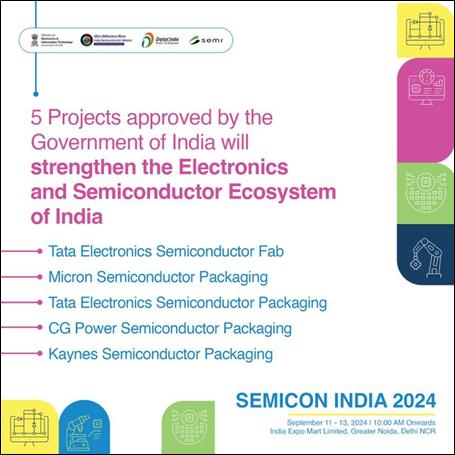
Recently, the Union Cabinet, chaired by Prime Minister Narendra Modi, approved Kaynes Semicon Pvt Ltd's proposal to set up a semiconductor unit in Sanand, Gujarat. The proposed unit will be set up with an investment of Rs 3,300 crore. Its capacity will be 60 Lakh chips per day. The chips produced in this unit will cater to a wide variety of applications, including industrial, automotive, electric vehicles, consumer electronics, telecom, mobile phones, etc.
Earlier, the Union Cabinet chaired by Prime Minister Narendra Modi had approved the establishment of three semiconductor units under ‘Development of Semiconductors and Display Manufacturing Ecosystems in India on February 29, 2024.
1. Semiconductor Fab with 50,000 wfsm capacity:
- Tata Electronics Private Limited (“TEPL”) will set up a semiconductor fab in partnership with Powerchip Semiconductor Manufacturing Corp (PSMC) of Taiwan.
- Investment: This fab will be constructed in Dholera, Gujarat, and with a cost of Rs.91,000 crore.
- Capacity: 50,000 wafer starts per month (WSPM)
2. Semiconductor ATMP unit in Assam:
- Tata Semiconductor Assembly and Test Pvt Ltd (“TSAT”) will set up a semiconductor unit in Morigaon, Assam.
- Investment: This unit will be set up with an investment of Rs.27,000 crore.
- Capacity: 48 million per day
- It is expected to generate 15,000 direct and 11,000-13,000 indirect jobs.
3. Semiconductor ATMP unit for specialized chips:
- CG Power, in partnership with Renesas Electronics Corporation, Japan and Stars Microelectronics, Thailand, will set up a semiconductor unit in Sanand, Gujarat.
- Investment: This unit will be set up with an investment of Rs.7,600 crore.
- Capacity: 15 million per day
4. Micron Semiconductor facility – Memory and Storage Products - Sanad, Gujarat
- Investment: A capital investment of Rs 22,516 crore with 50% fiscal support from the Government of India on a pari passu basis.
- Employment: Expected to create up to 5,000 direct and 15,000 indirect job opportunities over the next five years.
With these units, India is establishing the semiconductor ecosystem. India already has deep capabilities in chip design, and with these units, it will develop capabilities in chip fabrication.
They will accelerate employment creation in downstream automotive, electronics, telecom, industrial, and other semiconductor-consuming industries.
National Green Hydrogen Mission
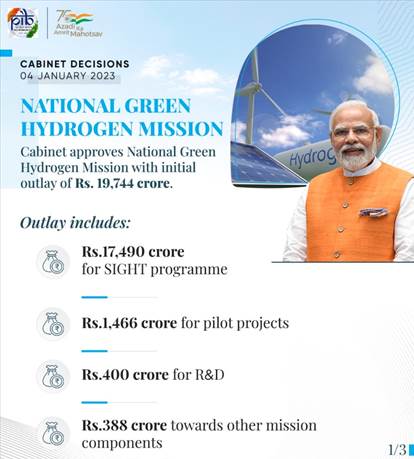
The Union Cabinet approved the National Green Hydrogen Mission on 4th January 2023, with an outlay of ₹ 19,744 crore. The overarching objective of the Mission is to make India a Global Hub for production, usage and export of Green Hydrogen and its derivatives, by targeting production of 5 MMT per annum of Green Hydrogen by 2030.
The Green Hydrogen production capacity envisaged by 2030 is likely to leverage over ₹8 lakh crore in total investments in the Green Hydrogen industry. This investment is estimated to create 6,00,000 jobs by 2030. Green Hydrogen has the potential to replace the utilization of imported fossil fuels across various sectors, including fertilizer production, petroleum refining, the mobility sector, steel production and shipping propulsion applications. The Mission is expected to reduce a cumulative ₹ 1 lakh crore worth of fossil fuel imports by 2030.
Cabinet approves 12 Industrial nodes/cities under the National Industrial Corridor Development Programme
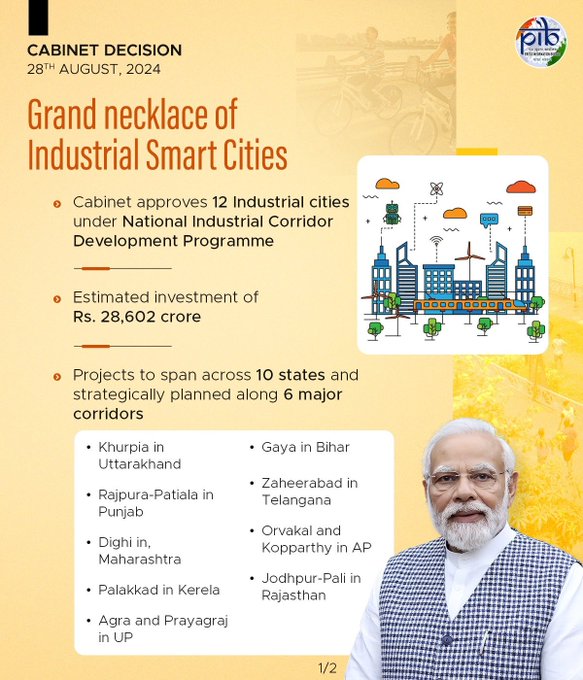
India will soon wear a grand necklace of Industrial Smart Cities. The cabinet recently approved 12 new project proposals under the National Industrial Corridor Development Programme (NICDP) with an estimated investment of Rs. 28,602 crore. This move is set to transform the country's industrial landscape, creating a robust network of industrial nodes and cities that will significantly boost economic growth and global competitiveness.
Spanning across ten states and strategically planned along six major corridors, these projects represent a significant leap forward in India’s quest to enhance its manufacturing capabilities and economic growth. These industrial areas will be located in Khurpia in Uttrakhand, Rajpura-Patiala in Punjab, Dighi in Maharashtra, Palakkad in Kerela, Agra and Prayagraj in UP, Gaya in Bihar, Zaheerabad in Telangana, Orvakal and Kopparthy in AP and Jodhpur-Pali in Rajasthan.
Economic Impact and Employment Generation: NICDP is expected to generate significant employment opportunities, with an estimated 1 million direct jobs and up to 3 million indirect jobs being created through planned industrialization. This will not only provide livelihood opportunities but also contribute to the socio-economic upliftment of the regions where these projects are being implemented.
Electric Vehicles
India needs electric vehicles (EVs) to address several pressing issues, including environmental pollution, energy security, and economic sustainability. The widespread adoption of EVs can significantly reduce air pollution, a major public health concern in many Indian cities. By shifting from fossil fuels to electric power, India can decrease its dependency on oil imports, enhance national energy security, and reduce its vulnerability to global oil price fluctuations. Embracing electric vehicles is a critical step towards India's cleaner, healthier, and more sustainable future.
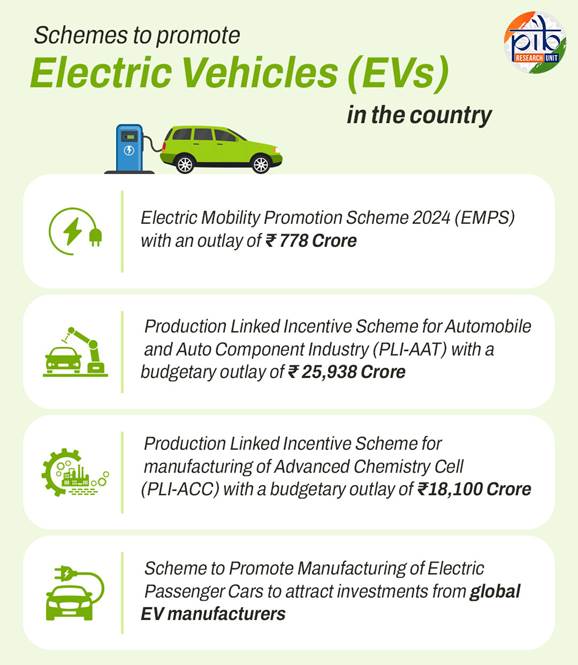
Ministry of Heavy Industries is currently implementing the following schemes to promote Electric Vehicles (EVs) in the country: -
- Electric Mobility Promotion Scheme 2024 (EMPS) with an outlay of ₹ 778 Crore for a period 6 months, w.e.f. 1st April 2024 till 30th September 2024, which provides incentives to buyers of e-2W and e-3W.
- Production Linked Incentive Scheme for Automobile and Auto Component Industry (PLI-AAT) with a budgetary outlay of ₹ 25,938 Crore. The scheme incentivises various categories of electric vehicles including e-2W, e-3W, e-4W, e-buses & e-trucks also.
- Production Linked Incentive Scheme for manufacturing of Advanced Chemistry Cell (PLI-ACC) in the country with a budgetary outlay of ₹18,100 Crore.
- Scheme to Promote Manufacturing of Electric Passenger Cars to attract investments from global EV manufacturers and promote India as a manufacturing destination for e-vehicles.
The Ministry of Heavy Industries (MHI) formulated a Scheme namely; Faster Adoption and Manufacturing of (Hybrid &) Electric Vehicles in India (FAME India) Scheme in 2015 to promote adoption of electric/ hybrid vehicles (xEVs) in India. The Phase-I of the scheme was available up to 31st March, 2019 with budget outlay of Rs. 895 Crore. This phase of FAME India Scheme had four focus areas i.e. technological development, demand generation, pilot project and charging infrastructure components.
In the 1st phase of the scheme, about 2.8 lakh xEVs were supported with total demand incentives of Rs. 359 Crore (Approx). In addition, 425 electric and hybrid buses, as sanctioned under first phase of the scheme were deployed across various cities in the country with Government Incentive of about Rs. 280 Crore. The Ministry of Heavy Industries had also sanctioned about 520 Charging Stations/ Infrastructure for Rs. 43 Crore (approx.) under Phase-I of FAME India Scheme. Based on outcome and experience gained during Phase-I of FAME India Scheme and after having consultations with all stakeholders, including Industry and Industry Associations, the Government notified Phase-II of FAME India Scheme for a period of five years commencing from 1st Apri1, 2019 with a total budgetary support of Rs. 11,500 crore.
This phase-II mainly focused on supporting electrification of public & shared transportation, and aimed to support through demand incentive 7,262 e-Buses, 1,55,536 e-3 Wheelers, 30,461 e-4 Wheeler Passenger Cars and 15,50,225 e-2 Wheelers. In addition, creation of charging infrastructure is also supported under the Scheme. Under Phase-II of FAME India Scheme, as on 31/07/2024, claims of 16,71,606 electric vehicles for Rs. 6,825 crore have been submitted for reimbursement of subsidy by the OEMs (EV manufacturers). Further, 6862 electric buses were sanctioned to various cities/STUs/State Govt. entities for intra-city operations under the FAME-II Scheme. Out of 6,862 e-buses, 4,853 e-buses have been supplied till 31st July, 2024.
MHI has also sanctioned Rs. 800 Crore as capital subsidy to the three Oil Marketing Companies (OMCs) of the Ministry of Petroleum and Natural Gas (MoPNG) for establishment of 7,432 electric vehicle public charging stations. Subsidy of Rs.560 crore has already been released to OMCs. Further, in March 2024, MHI sanctioned additional Rs.73.50 Crore under FAME II to OMCs for set up/upgradation 980 public fast charging stations by installing new chargers across the country. Subsidy of Rs.51.45 crore has already been released to OMCs.
Renewable Energy
Ministry of New and Renewable Energy is working towards the target of 500 GW of installed electricity generation capacity from non-fossil sources by 2030. Further, in its Nationally Determined Contribution (NDC) submitted to the United Nations Framework Convention for Climate Change (UNFCCC), India has committed to achieving about 50 per cent cumulative electric power installed capacity from non-fossil fuel-based energy resources by 2030.
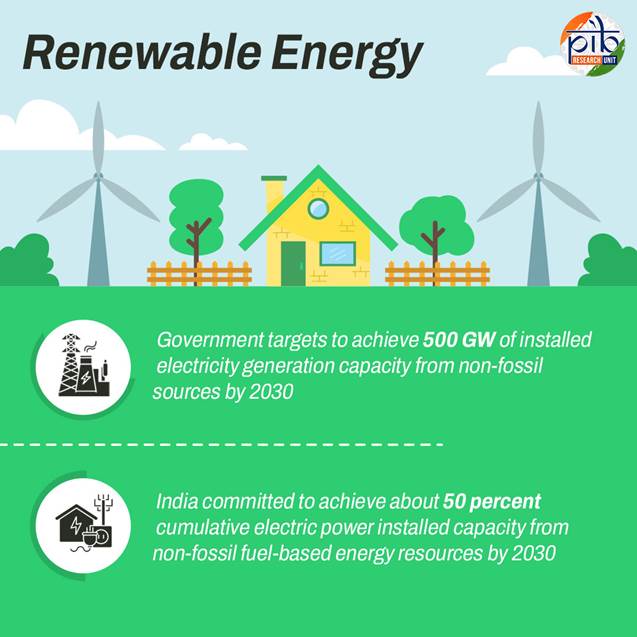
The following steps have been taken to increase the production capacity of renewable energy between 2014-15 to 2023-24 in the country: -
The installed capacity which was 2,48,554 MW in March 2014 has been increased to 4,46,190 MW in June 2024. Installed capacity of Renewable sector has increased from 75,519 MW in March 2014 to 1,95,013 MW in June 2024.
India has committed to augment non fossil fuel based installed electricity generation capacity to over 5,00,000 MW by 2031-32. Transmission plan for integration of 5,00,000 MW RE capacity is being implemented in a phased manner commensurate with RE capacity addition.
Government have constructed Green Energy Corridors and put in place 13 Renewable Energy Management Centres.
Waiver of ISTS charges on transmission of electricity generated from Solar, Wind, Pumped Storage Plants and Battery Energy Storage Systems.
In 2019, Government announced measures to promote Hydro Power Sector such as Declaring Large Hydro Projects (>25 MW) as Renewable Energy source, Tariff rationalization measures for bringing down hydropower tariff, Budgetary Support for Flood Moderation/ Storage Hydro Electric Projects (HEPs), Budgetary Support to Cost of Enabling Infrastructure i.e., roads/bridges, etc.
Setting up of Ultra Mega Renewable Energy Parks to provide land and transmission to RE developers for installation of RE projects at large scale.
Solar energy
Solar energy is the most abundant & cleanest energy resource on earth. India’s total solar energy potential has been estimated to be 748 GWp (Giga Watt peak), as estimated by the National Institute of Solar Energy (NISE), on the basis of the data from the Waste Land Atlas of India 2010. The Government of India has recognized and identified solar energy potential, and there has been an increase of 3000 % in solar energy capacity during the past ten years. The Government has set a target of achieving 500 GW of installed capacity from non-fossil fuel sources by 2030, in line with the Prime Minister’s announcement at COP-26, held in Glasgow.
Government has taken several steps for promotion of solar energy in the country. These include:
Permitting Foreign Direct Investment (FDI) up to 100 percent under the automatic route,
Waiver of Inter State Transmission System (ISTS) charges for inter-state sale of solar and wind power for projects to be commissioned by 30th June 2025,
Declaration of trajectory for Renewable Purchase Obligation (RPO) up to the year 2029-30,
Notification of standards for deployment of solar photovoltaic system/devices,
Setting up of Project Development Cell for attracting and facilitating investments,
Standard Bidding Guidelines for tariff based competitive bidding process for procurement of Power from Grid Connected Solar PV and Wind Projects.
Government has issued orders that power shall be dispatched against Letter of Credit (LC) or advance payment to ensure timely payment by distribution licensees to RE generators.
Notification of Promoting Renewable Energy through Green Energy Open Access Rules 2022.
Notification of “The electricity (Late Payment Surcharge and related matters) Rules 2002 (LPS rules).
Launch of Green Term Ahead Market (GTAM) to facilitate sale of Renewable Energy power including Solar power through exchanges.
International Solar Alliance (ISA) is part of the Prime Minister’s vision to bring clean and affordable energy within the reach of all and create a sustainable world. The ISA was launched jointly by India and France after COP21 in Paris. ISA is India’s first international and inter-governmental organization headquartered in India.
The International Solar Alliance is an international organisation with 109 member countries. It works with governments to improve energy access and security worldwide and promote solar power as a sustainable way to transition to a carbon-neutral future. ISA’s mission is to unlock US$ 1 trillion of investments in solar by 2030 while reducing the cost of the technology and its financing. The Sixth Assembly of the International Solar Alliance was held in New Delhi from October 30 - November 2,
2023.
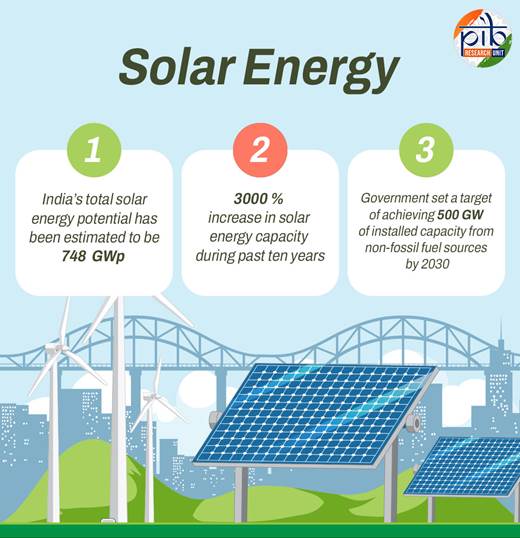
Production Linked Incentive Schemes
Keeping in view India's vision of becoming 'Atmanirbhar', Production Linked Incentive (PLI) Schemes for 14 key sectors have been announced with an outlay of Rs. 1.97 lakh crore (over US$26 billion) to enhance India's Manufacturing capabilities and Exports.
The 14 sectors are:
(i) Mobile Manufacturing and Specified Electronic Components,
(ii) Critical Key Starting Materials/Drug Intermediaries & Active Pharmaceutical Ingredients,
(iii) Manufacturing of Medical Devices
(iv) Automobiles and Auto Components,
(v) Pharmaceuticals Drugs,
(vi) Specialty Steel,
(vii)Telecom & Networking Products,
(viii)Electronic/Technology Products,
(ix) White Goods (ACs and LEDs),
(x) Food Products,
(xi) Textile Products: MMF segment and technical textiles,
(xii) High efficiency solar PV modules,
(xiii) Advanced Chemistry Cell (ACC) Battery, and
(xiv) Drones and Drone Components.
The purpose of the PLI Schemes is to attract investments in key sectors and cutting-edge technology, ensure efficiency and bring economies of size and scale in the manufacturing sector and make Indian companies and manufacturers globally competitive. These schemes have the potential to significantly boost production, increase manufacturing activities and contribute to economic growth over the next five years or so. As of 30 July 2024, 755 applications have been approved across 14 sectors. Investment of Rs. 1.23 lakh crore have been realised till March 2024 resulting in employment generation of around 8 lakhs.
The criteria employed in the selection of beneficiaries under PLI Schemes include but are not limited to willingness to make required investments, production of approved product categories under respective schemes, eligible net worth, domestic value addition, etc., as mentioned in Scheme Guidelines issued by the implementing Ministries/ Departments.
PLI Scheme for Automobile and Auto Components (PLI-Auto) and; PLI Scheme on National Programme on Advanced Chemistry Cell (PLI-ACC) Battery storage are being implemented by the Ministry of Heavy Industries. Under both Schemes, expenditure incurred by the beneficiary firms on Research and Development is considered as an eligible investment, to enable them to adopt latest technology in implementation of their projects.
Information Technology (IT) and Software services
Over the past decade, information and computer-related services have become increasingly significant, with their share of total GVA rising from 3.2 per cent in FY13 to 5.9 per cent in FY23. Despite the pandemic-induced economic downturn, this sector achieved a real growth rate of 10.4 per cent in FY21. The COVID-19 pandemic expedited the advancement and uptake of technology-driven solutions, fuelling the growth of this sector.
In the last decade, the industry has grown many folds in revenue terms, and relative share to India’s GDP is around 7% in FY2023-24. The Indian IT/ ITeS industry has a leading position globally and has been progressively contributing to the growth of exports and creation of employment opportunities. India’s IT-BPM industry (excluding e-commerce) is expected to reach at USD 254 billion, including exports of around 200 USD Billion in FY2023-24 (E). The IT-ITeS Industry has also created large employment opportunities and is estimated to employ 5.43 million professionals, an addition of 60,000 people over FY 2022-2023 (E). Women employees account for 36% share in total industry employee base. The flourishing growth of IT services has also supported the expansion of Global Capability Centers (GCCs) and the tech start-up ecosystem in India.
Several initiatives are in place to bridge the talent gap. Conceived as a first-of-its-kind initiative, ‘Future Skills PRIME’, which is a joint initiative by the Ministry of Electronics & Information Technology (MeitY) and NASSCOM, to create an up-skilling and re-skilling ecosystem in focus areas to facilitate the continuous enhancement of skills of IT professionals in line with their aspirations and aptitude.
The Government initiated a Digital Skilling Program in emerging and future technologies, aiming to skill, reskill, and upskill one crore students through internships, apprenticeships, and employment opportunities.
Pradhan Mantri Kaushal Vikas Yojana (PMKVY 4.0) focuses on skill development among youth, offering training in cutting-edge fields such as Industry 4.0, AI, robotics, mechatronics, Internet of Things, and drones.
To further leverage the technological advancements, the Government has envisioned the India AI programme as a mission-centric approach for leveraging transformative technologies to boost inclusion, innovation, and adoption for social impact. The Union Cabinet has approved an allocation of over ₹10,300 crore towards the comprehensive IndiaAl Mission to democratise access to Al innovation pillars and ensure global competitiveness of India’s Al ecosystem.
This mission drives responsible and inclusive growth of India's AI ecosystem through following seven pillars:
IndiaAI Compute Capacity: This pillar focuses on creating a scalable AI computing ecosystem with over 10,000 GPUs through public-private partnerships to meet the demands of India's growing AI startups and research community. An AI marketplace will offer AI as a service and a pre-trained model, serving as a central hub for essential AI resources.
IndiaAI Innovation Centre: This centre is dedicated to developing and deploying indigenous Large Multimodal Models (LMMs) and domain-specific foundational models in critical sectors.
IndiaAI Datasets Platform: This platform aims to streamline access to high-quality non-personal datasets for AI innovation. A unified data platform will provide seamless access to these datasets for Indian startups and researchers.
IndiaAI Application Development Initiative: This initiative promotes AI applications in critical sectors by addressing problem statements from Central Ministries, State Departments, and other institutions. It focuses on developing, scaling, and promoting the adoption of impactful AI solutions with the potential for large-scale socio-economic transformation.
IndiaAI FutureSkills: This pillar aims to reduce barriers to entry into AI programs by increasing AI courses at the undergraduate, master's, and Ph.D. levels. Data and AI Labs will be established in Tier 2 and Tier 3 cities to offer foundational courses.
IndiaAI Startup Financing: This pillar supports and accelerates deep-tech AI startups by providing streamlined access to funding for innovative AI projects.
Safe & Trusted AI: This pillar focuses on ensuring the responsible development, deployment, and adoption of AI by implementing Responsible AI projects, developing indigenous tools and frameworks, self-assessment checklists for innovators, and other guidelines and governance frameworks.
As part of building ‘AI in India and AI for India’, the first edition of the India AI was released in October 2023.
Further, India is the founding member of the Global Partnership on Artificial Intelligence (GPAI), having joined the multi-stakeholder initiative in June 2020.
Under the Digital India programme, initiated in July 2015 to transform India into a digitally empowered society and knowledge economy, various digital initiatives have been undertaken for the delivery of citizen-centric services. In FY 2023, the technology industry is estimated to have 5.4 Mn employees and contribution of 53% in India’s service exports. Government of India has taken some major initiatives to promote IT/ ITeS sector in India. Both central and state governments in India have taken steps towards developing technology solutions to digitally enable citizen services. The government plans to focus in areas such as cybersecurity, hyper-scale computing, artificial intelligence, and blockchain. With data costs of INR 10/GB ($0.12/GB), India has one of the lowest data costs in the world and also has the second-highest number of internet subscribers in the world.
Pharma and Healthcare Industry
The Drugs and pharmaceuticals exports increased by 8.36% from USD 2.13 Billion in July 2023 to USD 2.31 Billion in July 2024. The Indian Government has identified the medical devices as a priority sector for the flagship 'Make in India' program and is committed to strengthen the manufacturing ecosystem. India is the fourth largest medical devices market in Asia.
Currently, the Indian market has high reliance on imports but in recent times the exports have seen a surged. ‘Atmanirbhar’ Bharat mission is providing an impetus to India’s vision of becoming a global manufacturing hub for medical devices. Recent initiatives for instance, The Production Linked Incentive Scheme (PLI) and Promotion of Medical Devices Parks Scheme, are a testimony to this. These schemes have been cogently constructed to incentivize large-scale manufacturing and to build required infrastructure for developing manufacturing clusters within India.
To encourage domestic manufacturing of high-end medical devices to reduce imports dependence and to boost domestic manufacturing, the Department of Pharmaceuticals, Ministry of Chemicals and Fertilizers has taken several measures, which are as under:
Production Linked Incentive (PLI) scheme for promoting domestic manufacturing of Medical Devices (PLI MD) with total financial outlay of Rs. 3,420 crore and tenure from FY 2020-21 to FY 2027-28. The financial incentive is given to selected companies at the rate of 5% on incremental sales of medical devices manufactured in India and covered under the four target segments of the scheme, for a period of five (5) years. The four target segments are – (I) Radiotherapy, (II) Imaging Devices, (III) Anaesthesia, Cardio-respiratory & Critical Care, (IV) Implants. 26 participants have been approved under the scheme, of which 11 are MSMEs.
Production Linked Incentive (PLI) scheme for Pharmaceuticals, with a financial outlay of Rs. 15,000 crores and the tenure from FY 2020-21 to FY 2028-29, provides for financial incentive to 55 selected applicants, which includes five selected applicants of In-Vitro Diagnostics (IVD) devices, of which four are MSMEs. The incentive period under the scheme is for six years.
The scheme Promotion of Medical Devices Parks, with a total financial outlay of Rs. 400 crore and the tenure from FY 2020-21 to FY 2024-25, provides for the maximum financial assistance of Rs. 100 crore each to 4 selected States/Union Territories for creation of Common Infrastructure Facilities in the upcoming Medical Devices Parks. Under the scheme, final approval for financial assistance of Rs. 100 crore each, has been given to the States of Himachal Pradesh, Madhya Pradesh, Tamil Nadu, and Uttar Pradesh.
The scheme Assistance to Medical Device Clusters for Common Facilities (AMD-CF) intends to provide financial incentive to medical devices clusters to develop common infrastructure facilities like medical devices testing labs, E-waste treatment facility, logistic centre.
On 2 March 2024, 27 greenfield bulk drug park projects and 13 greenfield manufacturing plants for medical devices were virtually inaugurated.
PLI scheme envisages manufacturing of 41 Bulk Drugs with a total outlay of Rs. 6,940 cr. during the tenure of the scheme from 2020-21 to 2029-30
E-Commerce and Fintech Industry
On 10 September, 2024, Union Minister of Commerce and Industry Piyush Goyal launches Trade Connect e-Platform in New Delhi. The Trade Connect e-Platform (https://trade.gov.in), is a new digital initiative aimed at transforming the landscape of international trade for Indian exporters, especially MSMEs (Medium, Small and Medium Enterprises). The platform, developed in collaboration with key partners including the Ministry of MSME, EXIM Bank, Department of Financial Services (DFS), and the Ministry of External Affairs (MEA), is set to address information asymmetry by offering exporters comprehensive support and resources.
The Trade Connect e-Platform serves as a one-stop solution, providing exporters with near real-time access to critical trade-related information, while seamlessly connecting them to key government entities such as the Indian Missions abroad, Department of Commerce, Export Promotion Councils, and other trade experts. Whether a seasoned exporter or a new entrant, the platform is designed to assist businesses at every stage of their export journey. This e-Platform shall connect more than 6 Lakh IEC holders, over 180 Indian Mission officials, over 600 Export Promotion Council Officials, besides the officials from DGFT, DoC, banks etc.
Government e-Marketplace (GeM)
The procurement on Government e-Marketplace (GeM) in FY2024-25 has already reached ₹1,92,433 Crore as of 08th August 2024 which is approx. 136 percent (%) growth over the same period in the last fiscal year, and is well poised to set new records in FY 2024-25. The procurement of Services on GeM has accelerated with the Gross Value Merchandise (GMV) of services reaching ₹3.91 lakh crore since its inception. In FY 2024-25, service procurement on GeM has already reached ₹80,493 crore. The platform has registered a 100% year-on-year growth in the last 3 fiscal years, with fulfilment of 62.86 Lakh orders worth approx. ₹ 4.03 Lakh Crore in GeM GMV in FY 2023-24.
So far, more than 1.5 Lakh Government buyers are interacting and procuring goods and services from approx. 23 Lakh sellers and service providers pan India, in 11,523 product and 327 service categories, sans intermediaries.
Since its launch on 9th August 2016, GeM has facilitated the procurement of common use Goods & Services by various Central/ State, Ministries/ Departments, Public Sector Enterprises (PSU), Autonomous Bodies, Panchayats, and Cooperative Societies. The genesis of GeM stems from the visionary approach of Prime Minister Narendra Modi in leveraging the digital public infrastructure for ushering a cashless, contactless, and paperless unified national procurement portal.
As part of its ongoing commitment to the Digital India vision, the Ministry of Electronics and Information Technology (MeitY) has launched the third phase of its capacity-building initiatives. These initiatives focus on critical areas such as Digital Public Infrastructure, Contract and Procurement Management, the Application of AI & ML, Managing Large Digital Transformation Projects, Digital Governance, and Data Management. To enhance the capabilities of officials at both Central and State levels, a series of specialized training programmes are being conducted across the country.
In a historic move, under India’s Presidency, the G20 Digital Economy Ministerial reached a groundbreaking consensus on how to effectively shape Digital Public Infrastructure (DPI) of the future. DPI has been collectively adopted by the G20. They also agreed to a G20 Framework for DPIs which consist of various components of DPI as well as suggested principles for development and deployment of DPIs. All G20 members acknowledged the need for a multistakeholder approach for financial and technical assistance to the countries in the Global South. In this regard, the G20 unanimously welcomed the Indian Presidency’s voluntary initiative of the One Future Alliance that seeks to support the needs of the developing countries for DPI.
The Union government is creating robust, transparent and efficient systems to strengthen financial markets with advanced technologies and regulatory frameworks Bharat’s fintech revolution is widespread for one to witness right from the moment of their arrival at the airport to street food and shopping experience. “In the last 10 years, the industry has received a record investment of more than 31 billion USD along with witnessing a startup growth of 500 percent.
The trinity of Jan Dhan, Aadhaar and Mobile have broken down the mentality of ‘Cash is King’ and made way for approximately half of the digital transactions in the world taking place in India. India’s UPI has become a major example of Fintech in the world” the Prime Minister said adding that it has enabled 27 X 7 banking services in every village and city in all weather conditions.
Fintech has played an impactful role in denting such a system and credited the emergence of transparency. He said that digital technology has introduced transparency in India and gave the example of the implementation of Direct Benefit Transfer used in hundreds of government schemes that has prevented leakages in the system. “Today, people can see the benefits of aligning with the formal banking system”.
Fintech has made access to credit easy and inclusive. For example, PM SVANidhi scheme, who has enabled street vendors to avail collateral-free loans and further expand their business with the help of digital transactions. Now, people can an easy access to the share markets and mutual funds, investment reports and opening demat accounts.
Telecom Industry
Aligning with Prime Minister Shri Narendra Modi’s vision of making India ‘Atmanirbhar’, The Production Linked Incentive (PLI) Scheme for Telecom and Networking Products and for Large Scale Electronic Manufacturing of Electronics have led to a significant increase in production, employment generation, economic growth, and exports in the country.
Within three years of the Telecom PLI scheme, the scheme has attracted an investment of Rs 3,400 crore; the telecom equipment production has exceeded the milestone of Rs 50,000 crore with exports totalling approximately Rs 10,500 crore, creating more than 17,800 direct jobs and many more indirect jobs. This milestone underscores the robust growth and competitiveness of India’s telecom manufacturing industry, driven by government initiatives to promote local production and reduce import dependency. The PLI scheme aims to enhance domestic manufacturing capabilities and make India a global hub for telecom equipment production. The scheme also offers financial incentives to manufacturers based on their incremental sales from products manufactured in India.
The Production Linked Incentive Scheme for Large Scale Electronic Manufacturing of Electronics covers the manufacture of mobile phones and its components. As a result of this PLI scheme, both the production and export of mobile phones from India has picked up greatly. India from being a large importer of mobile phones in 2014-15, when only 5.8 crore units were produced in the country, while 21 crore units were imported, in 2023-24, 33 crore units were produced in India and only 0.3 crore units were imported and close to 5 crore units were exported. The value of exports of mobile phones has gone up from Rs 1,556 crore in 2014-15 and just Rs 1,367 crore in 2017-18, to Rs 1,28,982 crore in 2023-24. Import of mobile phones was valued a Rs 48,609 crore in 2014-15 and has dropped to just Rs 7,665 crore in 2023-24. India has been importing telecom gear for many years, but the balance has changed due to the Make-in-India and PLI scheme, leading to the production of equipment valued at over Rs 50,000 crore in the country.
Key Highlights Telecom:
Industry Growth: The telecom equipment manufacturing sector has demonstrated exceptional growth, with total sales exceeding Rs 50,000 crores by PLI companies. Sales of Telecom & Networking Products by PLI beneficiary companies in FY 2023-24 has increased by 370% vis-a-vis Base Year (FY 2019-20).
Job Creation: The initiative has not only contributed to economic growth but also generated substantial employment opportunities across the value chain, from manufacturing to research and development, creating 17,800+ direct jobs and many more indirect jobs.
Reduced Import Dependency: By encouraging local production, the PLI scheme has significantly reduced the country’s reliance on imported telecom equipment, resulting in import substitution of 60% and India has become almost self–reliant in Antennae, GPON (Gigabit Passive Optical Network) & CPE (Customer Premises Equipment). Reducing import dependency has thereby enhanced national security and fostered self-reliance.
Global Competitiveness: Indian manufacturers are increasingly competing on a global scale, offering high-quality products at competitive prices.
Telecom equipment includes intricate items like radios, routers, and network equipment, among others. Furthermore, companies are permitted by the government to avail benefits for producing 5G equipments. 5G Telecom equipment manufactured in India is currently being exported to North America and Europe.
As a result of the PLI Scheme for Telecom and Networking Products and other related initiatives run by both DoT & MeitY, the gap between telecom imports and exports has reduced significantly with the total value of goods (both telecom equipment and mobiles put together) exported is over Rs 1.49 lakh crore as against imports of over Rs 1.53 lakh crore in FY 23-24.
In fact, over the last five years, the trade deficit in telecom (both telecom equipment and mobiles put together) has reduced from Rs 68,000 crore to Rs 4,000 crore and both the PLI Schemes have started to make Indian manufacturers globally competitive, attract investment in the areas of core competency and cutting-edge technology; ensure efficiencies; create economies of scale; enhance exports and make India an integral part of the global value chain. It has transformed India’s exports basket from traditional commodities to high value-added products.
IT Hardware Manufacturing
The Union Cabinet, chaired by Prime Minister Narendra Modi, in May 2023 approved the Production Linked Incentive Scheme 2.0 for IT Hardware with a budgetary outlay Rs. 17,000 crore. The salient features of the schemes are:
- PLI Scheme 2.0 for IT hardware covers laptops, tablets, all-in-one PCs, servers and ultra small form factor devices
- The budgetary outlay of the scheme is Rs. 17,000 crore
- The tenure of this scheme is 6 years
- Expected incremental production is Rs. 3.35 Lakh crore
- Expected incremental investment is Rs. 2,430 crore
- Expected incremental direct employment is 75,000
India is emerging as a trusted supply chain partner for all global majors. Large IT hardware companies have shown keen interest in establishing manufacturing facilities in India. This is further supported by strong IT services industry having good demand within the country. Most majors would like to supply domestic markets within India from a facility situated in India as well as make India an export hub.
Applications of 27 IT hardware manufacturers have also been approved. IT hardware of well-known brands such as Acer, Asus, Dell, HP, Lenovo, etc are being manufactured in India. The expected outcomes of this approval over the tenure of the scheme are as follows:
-
- Employment: around 2 lakhs
- About 50,000 (direct) and about 1.5 lakh (indirect)
- Value of IT hardware production: 3 lakh 50 thousand crore rupees (42 billion US dollars)
- Investment by companies: 3,000 crore rupees (360 million US dollars)
Further, a new MoU paves the way for local manufacturing of HP laptops, desktops, and all-in-one PCs, boosting India's electronics sector. Starting January 2025, Padget will manufacture 20 lakh HP laptops, desktops, and PCs annually at its 3 lakh sq ft facility in Chennai, creating 1,500 direct jobs.
Energy Security
The Union Budget 2024-25 focused on the theme of "Energy Security”. The finance minister said, in line with the announcement in the interim budget, PM Surya Ghar Muft Bijli Yojana has been launched to install rooftop solar plants to enable 1 crore households obtain free electricity up to 300 units every month. The scheme has generated a remarkable response, with more than 1.28 crore registrations and 14 lakh applications. Nuclear energy is expected to form a very significant part of the energy mix for Viksit Bharat. The other energy security related announcements made under the budget are :-
- Policy document on ‘Energy Transition Pathways’ to balance the imperatives of employment, growth and environmental sustainability to be brought out.
- Policy for promoting pumped storage projects for electricity storage to be brought out.
- Government to partner with private sector for R&D of Bharat Small Modular Reactor and newer technologies for nuclear energy, and to set up Bharat Small Reactors.
- Joint venture proposed between NTPC and BHEL to set up a full scale 800 MW commercial plant using Advanced Ultra Super Critical (AUSC) technology.
- Appropriate regulations for transition of ‘hard to abate’ industries from the current ‘Perform, Achieve and Trade’ mode to ‘Indian Carbon Market’ mode to be put in place.
- Capital goods for use in manufacture of solar cells and panels exempted from customs duty.
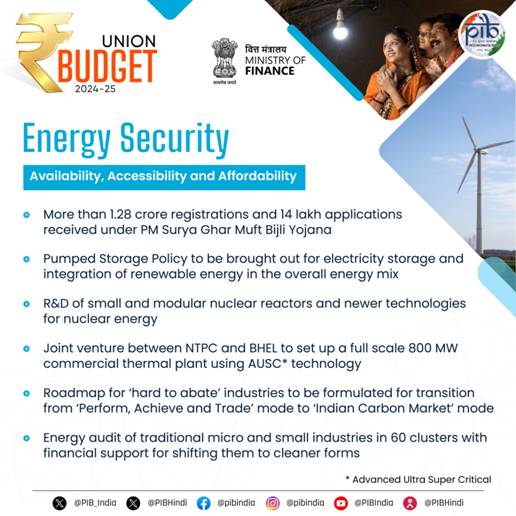
Industry 4.0
Industry 4.0 marks a transformative phase in manufacturing by integrating cyber-physical systems, AI, and IoT technologies. The goal is to create smart factories where machines, systems, and humans interact seamlessly in real-time, leading to higher efficiency, minimized waste, and optimized resource usage.
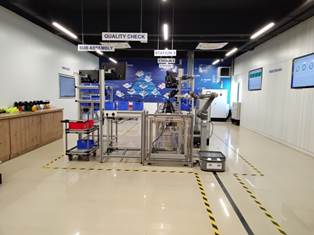
India’s approach under Industry 4.0, particularly through the SAMARTH Udyog Bharat 4.0 initiative, focuses on making Indian industries globally competitive by balancing high automation with cost-efficient, human-empowered smart technologies. The establishment of centers like the C4i4 Lab Pune supports innovation and the adoption of these advanced technologies to boost the global standing of Indian manufacturing.
Conclusion
The combination of robust government support, international partnerships, and strategic investments in areas like electric vehicles, renewable energy, semiconductor mission is turning India into a powerhouse for sustainable and advanced technologies. As the country continues to strengthen its electronics manufacturing capabilities and foster an innovation-driven ecosystem, it stands poised to play a pivotal role in the global economy. By reducing dependency on imports, nurturing home-grown talent, and advancing in new-age technologies, India is setting the stage for long-term growth, increased exports, and job creation, ensuring its leadership in the future of technology and manufacturing.
References
https://pib.gov.in/PressReleaseIframePage.aspx?PRID=2053280.
https://pib.gov.in/PressReleseDetailm.aspx?PRID=2010135
https://x.com/GoI_MeitY/status/1833081909196595568?t=xSv7pqXeEIEsRb_RxFzm5Q&s=08
https://pib.gov.in/PressReleaseIframePage.aspx?PRID=1989807
https://pib.gov.in/Pressreleaseshare.aspx?PRID=2003561
https://www.pib.gov.in/PressReleasePage.aspx?PRID=2035618
https://x.com/PIB_India/status/1610589817506791424/photo/1
https://pib.gov.in/PressReleasePage.aspx?PRID=2031963
https://x.com/PIB_India/status/1833381177379721447
https://pib.gov.in/PressReleasePage.aspx?PRID=2039119.
https://pib.gov.in/PressReleasePage.aspx?PRID=2045238
https://www.investindia.gov.in/schemes-for-medical-devices-manufacturing
https://pib.gov.in/PressReleaseIframePage.aspx?PRID=2003866.
https://pib.gov.in/PressReleaseIframePage.aspx?PRID=2010924
Click here to see in PDF:
Santosh Kumar/ Sarla Meena/ Ritu Kataria/ Aswathy Nair
(Backgrounder ID: 152130)
Visitor Counter : 11856
Provide suggestions / comments